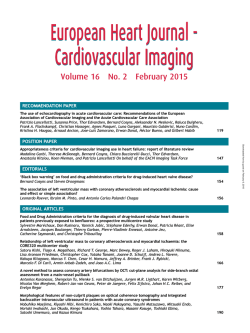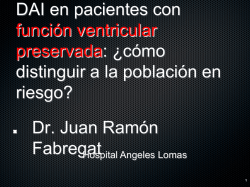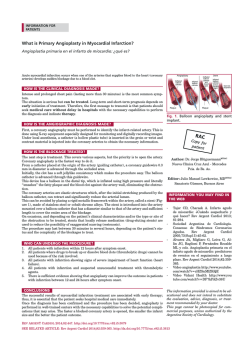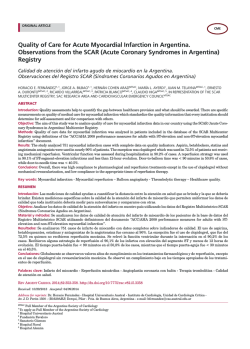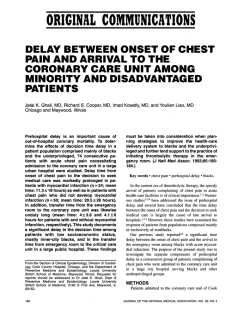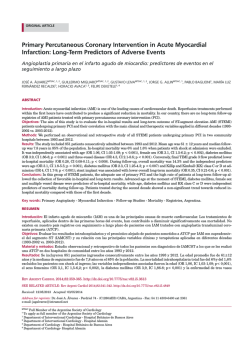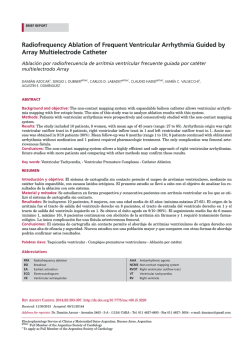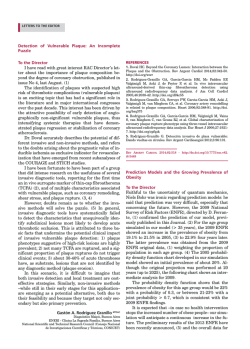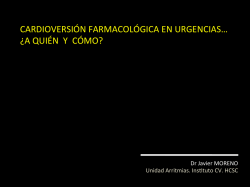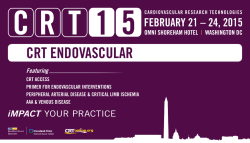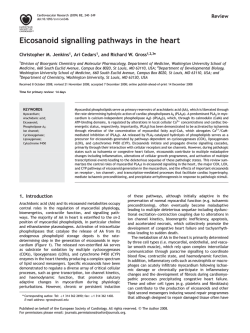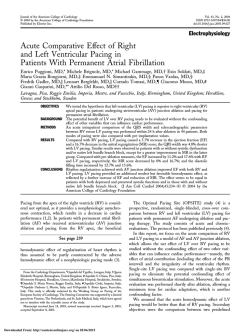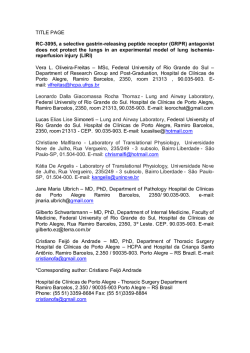
24323___.PDF - Radboud Repository
PDF hosted at the Radboud Repository of the Radboud University Nijmegen The following full text is a publisher's version. For additional information about this publication click this link. http://hdl.handle.net/2066/24323 Please be advised that this information was generated on 2015-02-06 and may be subject to change. Ill Long-term Implications of Reocclusion on Left Ventricular Size and Function After Successful Thrombolysis for First Anterior Myocardial Infarction Francisca Nijland, MD; Otto Kamp, MD, PhD; Freek W.A. Verheugt, MD, PhD; Gerrit Veen, MD; Cees A. Visser, MD, PhD Background Successful thrombolysis can prevent left ven tricular dilatation after acute myocardial infarction. H owever, in almost 30% of patients, reocclusion occurs. The aim o f this study was to assess the long-term implications o f reocclusion on left ventricular size and function. M ethods a n d Results Fifty-six patients were studied with two-dimensional echocardiography at baseline (2 ± 1.6 days) and 5 .0 ± 1.4 years after first anterior myocardial infarction. All pa tients (a subset of those enrolled in the APRICOT trial) had a patent infarct-related artery when studied < 4 8 hours after throm bolysis and underwent repeat coronary angiography at 3 months. Baseline characteristics were comparable in patients with (n = 17) and without reocclusion (n = 3 9 ). Left ventricular volume indexes were stable in patients without reocclusion. Patients with reoc clusion, however, showed a significant increase in end-diastolic volume index (EDVI; P = .0 0 8 ) and end-systolic volume index (ESVI; P = .0 3 9 ). Furthermore, patients without reocclusion dem- onstrated improvement in wall motion score index (WMSI; P = .0 0 0 1 ) and ejection fraction (EF; P = .0 1 6 ) , whereas patients with reocclusion did not. After 5 years, patients with reocclusion had significantly larger volum e indexes (EDVI, 9 9 ± 4 1 versus 7 6 ± 2 2 m L /m 2, P = .0 0 7 ; ESVI, 5 9 + 4 0 versus 3 9 ± 2 0 m L /m 2, i ^ . 0 1 7 ) and more compromised left ventricular function (WMSI, 1.63'±0,33 versus 1 .3 9 ± 0 .3 2 , ^ = .0 1 3 ; EF, 45±13% versus 5 1 ± 1 1 % , P - , 0 1 1 ) than patients without reocclusion. Multivariate analysis identified baseline W M SI and reocclusion as significant independent predictors o f left ventricular dilatation. C on clu sion s Reocclusion o f the infarct-related artery within 3 months o f successful thrombolysis is associated with left ven tricular dilatation and is detrimental to functional recovery o f left ventricular function 5 years after first anterior myocardial infarc tion. (Circulation. 1997;95:111-117.) K ey W ords • myocardial infarction • occlusion • thrombolysis • echocardiography • remodeling eft ventricular remodeling after acute myocardial infarction, resulting in enlargement of the ven tricle, is a progressive process beginning in the early phase and continuing for months and years.1-4 It occurs predominantly after a large transmural anterior wall infarction2*5 and carries an adverse prognosis.6*7 There are supporting experimental and clinical data that successful reperfusion of the infarct-related artery can prevent this sequela by limiting infarct expansion.8-10Re cent clinical studies have shown that infarct-related artery patency is one of the most important determinants for ventricular remodeling after myocardial infarction.4*1U2 Initial success of thrombolysis, however, is followed by reocclusion in almost 30% of patients within 3 months after myocardial infarction.13*14 Reocclusion is associated with a more complicated hospital course,15 impaired short-term recovery of regional and global ventricular function,15-16 and an increase in end-systolic volume 3 months after myocardial infarction.16 Long-term data with respect to reocclusion are limited.17 Therefore, the aim of this study was to determine the implications of reocclusion on left ventricular size and function 5 years after first anterior myocardial infarction. L Received April 2, 1996; revision received August 12, 1996; ac cepted August 24, 1996. From the Department of Cardiology (F.N., O.K., G.V., C.A.V.), Institute for Cardiovascular Research, Research School Free Univer sity Hospital, Amsterdam, Netherlands, and Department o f Cardiol ogy (F.W.A.V.), University Hospital Sint Radboud, Nijmegen, Netherlands. Correspondence to Francisca Nijland, MD, Free University H os pital, Dept of Cardiology, PO Box 7057,1007 MB Amsterdam, Neth erlands. E-mail [email protected]. © 1997 American Heart Association, Inc. Methods Patient Population The study population consisted o f 56 patients who had been enrolled in the Antithrombotics in the Prevention o f Reocclusion in Coronary Thrombolysis (APRICOT) trial . s3 The entry criteria and study protocol have been described in detail previously. 13 In brief, patients younger than 71 years with symptoms o f acute myocardial infarction o f < 4 hours’ duration were included if STsegm ent elevation o f > 0 .2 m V was present in two contiguous leads o f a standard 12-lead ECG. All patients received intrave nous thrombolytic therapy with streptokinase or anistreplase. Coronary angiography was performed within 48 hours o f throm bolytic treatment. Only patients with a patent infarct-related ar tery, as described below , were eligible to enter the study. Then, patients were randomized to receive either coumadin, aspirin, or placebo. After 3 months, repeat coronary angiography was per formed to assess reocclusion. A conservative strategy was in tended, implying that revascularization procedures were per formed only for reasons of recurrent angina refractory to medical therapy. In case o f coronary angioplasty within 3 months, the status o f the infarct-related artery before angioplasty was used for analysis. For the present study, only patients with a left anterior descend ing artery-related myocardial infarction, enrolled in the Free Uni versity Hospital, w ho fulfilled the follow ing criteria were se lected: ( 1) enzymatically proven myocardial infarction, defined 112 Circulation Vol 95, No i January 7, 1997 as creatine kinase elevation exceeding twice the uppei limit ol normal; (2 ) both first and second coronary angiography were per formed; (3 ) two-dimensional echocardiography of adequate qual ity for quantitative analysis was performed during the early hos pital phase; (4 ) reocclusion had occurred in the absence oí documented reinfarction; and (5) no Q-wave myocardial reinfaretion had occurred during long-term follow-up. Q-wave myo cardial reinfarction was defined as recurrent ischemic chest pain accompanied by a rise in cardiac enzymes and appearance of new Q waves on the ECG. Surviving patients were invited to partic ipate in the follow-up investigation, which consisted of a twodimensional echocardiographic study. Of three patients who died during follow-up, an echocardiogram taken < 3 months before death was available for analysis. On the basis o f the results o f the second coronary angiography, two groups of patients were de fined: patients with and without reocclusion. Coronary Angiography Ail coronary angiograms of the APRICOT trial have been ex amined by an angiography committee, which consisted of three experienced cardiologists blinded to treatment allocation and clinical course of the patients. Decisions were made by consen sus. Patency o f the infarct-related artery was classified according to the European Cooperative Study Group 18 as grade 0, normal coronary artery; grade 1, <50% diameter stenosis; grade 2, 50% to 90% diameter stenosis; grade 3,91% to 99% diameter stenosis, complete filling within three cycles; grade 4, 91% to 99% di ameter stenosis, no complete filling within three cycles; and grade 5, 100% diameter stenosis. Patients with grade 1 to 3 stenosis were eligible for the study. Reocclusion was defined as grade 4 or 5 stenosis at follow-up coronary angiography. Quantitative angiographic analysis of the residual stenosis was performed with a personal computer-based QCA system (QCA-CMS, MEDIS Medical Imaging Systems). End-diastolic cine frames of at least two orthogonal views, clearly demonstrating the stenotic coro nary segment, were selected, magnified, and digitized. The boundaries of the selected segment of the coronary artery were detected automatically . 19 A diameter was computed perpendicu lar to the vessel centerline as the distance between the edges. A computer estimation of the original arterial dimension at the site o f obstruction was used to calculate the interpolated reference diameter. The mean percentage diameter stenosis was used for subsequent analysis. Two-dimensional Echocardiography The early echocardiographic studies were performed with ei ther an Advanced Technologies Laboratory ADR-4000 or a Hew lett-Packard Sonos 1000 using a 3.0- or 3.5-MHz transducer; fol low-up echocardiograms were performed by means of a Hewlett-Packard Sonos 1500 using a 2.5-MHz transducer. All examinations included standard parasternal and apical views and were stored on half-inch VHS videotape for subsequent analysis. Regional wall motion was assessed semi quantitatively by two experienced observers unaware of clinical or angiographic data, using a 13-segment division of the left ventricle.2DWall motion for each segment was graded visually as 1, normokinesia; 2 , hy pokinesia; 3, akinesia; and 4, dyskinesia. Wall motion score index was calculated by summing the scores for each segment and di viding by the number of segments analyzed. Left ventricular enddiastolic and end-systolic volumes were determined from apical two- and four-chamber views by use of the Simpson biplane for mula according to the recommendations of the American Society of Echocardiography .21 Tracing of the endocardial borders was performed on a digitized frame from the technically best cardiac cycle (Image Vue, Nova Microsonics), and volumes were nor malized for body surface area. An increase of >20% in enddiastolic volume index (EDVI) from baseline to follow-up was defined as left ventricular dilatation.22'24 Ejection fraction was calculated as (End-Diastolic Volume-End-Systolic Volume)/ End-Diastolic Volume. Statistical Analysis Data are presented as m ean±SD . Comparisons between groups for continuous data were made with an unpaired Student’s t test. Differences between proportions were assessed by x 2 analysis. Fisher’s exact test was used if there was an expected cell value < 5 . Changes in left ventricular volume and function over time were analyzed by paired Student’s t test. Statistical significance was defined as a value of P c . 0 5 . Stepwise logistic regression analysis was performed to determine which variables were in dependent predictors of left ventricular dilatation, Results Study Group Of 200 patients enrolled in the APRICOT trial in the Free University Hospital, 94 had a left anterior descending artery-related myocardial infarction. Eleven patients of this group underwent no second coronary angiography be cause of death (n=2), coronary surgery within 3 months (n = l), or patient refusal (n=8). Of the remaining 83 pa tients, 20 were excluded for aborted infarction (n=5), doc umented reinfarction during hospitalization (n=4), death without a second echocardiogram (n=8), or Q-wave myo cardial reinfarction during follow-up (n=3). Furthermore, in 3 patients, the first echocardiogram was of inadequate quality, and 4 patients were lost to follow-up. Patient Characteristics All 56 selected patients had a first myocardial infarction. Baseline characteristics of patients with and without reoc clusion are shown in Table 1. There were no significant differences between both groups with respect to age, sex, and medication or ventricular volume indexes and ejection fractions. Enzymatic infarct size and wall motion score index, both indicators of the extent of left ventricular dys function, were higher in patients who suffered reocclusion, although the difference was not significant. Patients with reocclusion had a higher mean percentage diameter ste nosis at first coronary angiography than patients with sus tained patency (P=.QQ01). Eleven patients suffered from recurrent angina pectoris before the second coronary an giography; 3 of these had reocclusion and 8 had no reoc clusion (P=NS). The incidence of non-Q-wave myocar dial reinfarction and unstable angina during the mean follow-up period of 5.0±1.4 years was similar (5% and 18%, respectively, in patients with persistent patency ver sus 6% and 18% in patients with reocclusion). Hospital ization for heart failure had occurred in 3 patients with reocclusion (18%) compared with 1 patient without reoc clusion (2.6% ;P—NS). At the time of follow-up echocar diography, there were no differences in New York Heart Association class; all patients were in class I or II. Revas cularization procedures have been performed in 9 (23%) of the 39 patients without reocclusion compared with 4 (24%) of the 17 patients with reocclusion (P=NS). Left Ventricular Volumes Fig 1 shows the impact of reocclusion of the infarctrelated artery on left ventricular volume. In patients with out reocclusion, left ventricular volume indexes were sta ble throughout the study period. EDVI tended to increase from 70±12 mL/m2 to 76±22 mL/m2, but this change was not statistically significant (P=.054). Also, end-systolic volume index (ESVI) remained unchanged, with a baseline value of 37± 11 mL/m2 and a follow-up value of 39±20 .( m L /m 2 ( j P = .5 8 \ In contrast, le ft ventricular v o lu m e in Reocclusion After Thrombolysis for First AMI Nijland et al T a b le 1. 113 Baseline C haracteristics Variables Age, y Male, n (%) Hypertension, n (%) Time to thrombolysis, h Peak creatine kinase, U/L Peak MB fraction, U/L Time to peak, h No. leads with ST elevation* No. pathological Q wavesf Multivessel disease, n {%) % Diameter stenosis IRV$ Medication at hospital discharge Nitrates, n (%) 0-Blockers, n (%) Calcium antagonists, n {%) ACE inhibitors, n {%) End-diastolic volume index, mL/m2 End-systolic volume index, mL/m2 Ejection fraction, % Wall motion score index No Reocclusion (n=39) Reocclusion (n=17) 56±10 30 (77) 11 (28) 53+10 17 (100) 4 (24) 1.8±0.8 2000+1901 163±126 12±4 5.51 ±1.35 2.1±1.5 14 (36) 51±12 2.3+0.9 2391+1281 184+123 13±4 P NS NS NS NS NS NS NS NS NS NS .0001 5.12±1.65 2.4+1.8 8(47) 64+5 1 3(8) 28 (72) 2(5) 5(13) 70±12 NS NS NS NS NS NS NS NS 1 (6) 11 (65) 1 (6) 2 (12) 37±11 48 ±8 76+14 42±11 45+6 1.55+0.24 1.64+0.21 IRV indicates Infarct-related vessel. Values are mean SD. *On the ECG before thrombolytic therapy. tO n the ECG at hospital discharge. ¿At first coronary angiography. dexes increased significantly in patients with reocclusion, EDVI from 76±14 mL/m2 to 99±4I mL/m2 (P=.008) and ESVI from 42± 11 mL/m2 to 59±40 mL/m2 (P=.039). The mean percentage change in volume indexes was signifi cantly higher in the reocclusion group than in patients with out reocclusion (EDVI, 23% versus 5%, P=.006; ESVI, 17% versus 1.4%, P=.015). After 5 years, patients with reocclusion had significantly larger ED Vis and ESVIs than patients with sustained patency (EDVI, P—.007; ESVI, P=. 017). Left Ventricular Function Fig 2 displays the impact of reocclusion on left ventric ular function. In patients without reocclusion, ejection fraction increased significantly from 48±8% to 51 ±11% (P=.016). With reocclusion, there was no change.: the baseline value was 45 ±6%, and the follow-up value was 45±13% (P=NS). At long-term follow-up, patients with out reocclusion had a higher ejection fraction than patients with reocclusion (P=.077). Patients without reocclusion showed an improvement in regional wall motion: the wall motion score index decreased End S y s t o l i c Volume Index End D iastolic Volume Index ml/m2 p*0.007 100 P' o.ooa i---) ml/m2 BO eo r p*0,017 ---- ! p * NS p- 0.039 f--- \ significantly from 1.55±0.24 to 1.39±0.32 (Pc.0001). In contrast, patients with reocclusion showed no change, with a baseline value of 1.64±0.2'1 and a follow-up value of 1.63±0.33 (P=NS). After 5 years, patients with sustained patency had a significantly better regional left ventricular function than patients with reocclusion (P=.013). Predictors of Left Ventricular Dilatation Left ventricular dilatation, defined as an increase of >20% in EDVI, was evident in 12 (21%) of the 56 pa tients. Table 2 shows the univariate predictors of left ven tricular dilatation. Peak MB fraction, number of leads with &l-mm ST elevation, number of pathological Q waves, wall motion score index, ESVI, and ejection fraction at baseline as well as reocclusion were all associated with a greater risk of left ventricular dilatation by univariate anal ysis. Logistic regression analysis revealed that baseline wall motion score index was more significantly related to ventricular dilatation than reocclusion and the number of Q waves on the ECG. When baseline wall motion score index was used as the first predictor in the multivariate model, reocclusion still added significantly to the predicWall Motion Score Index Ejection Fraction p- 0.077 p- 0.013 ------------ j p-NS I-- 1 0,0001 f—i --- 1 p■NS I-- 1 40 20 0 No Reoocluslon Reoocluslon No Reooolusion Reoocluslon No Reocclusion Reocclusion Baseline Fig 1. Change in left ventricular end-diastolic and end-systolic volume indexes between baseline and 5 years after myocardial infarction in patients with and without reocclusion. No Reocclusion Reoocluslon Y ///A Follow-up F ig 2. Change in ejection fraction and wail motion score indexes between baseline and 5 years after myocardial infarction in pa tients with and without reocclusion. 114 Circulation January 7, 1997 Vo I 95, No 1 % tion of dilatation. Fig 3 shows the relation between base line wall motion score index and the risk of left ventricular dilatation in patients with and without reocclusion. For a similar extent of regional dysfunction, the risk of ventric ular dilatation was smaller in patients without reocclusion than in patients with reocclusion. Patients with a high wall motion score index at baseline with reocclusion were at the highest risk for left ventricular dilatation. Discussion Left Ventricular Dilatation and Patency of the Infarct-Related Artery The patency status of the infarct-related artery has been identified as one of the most important determinants for left ventricular dilatation after myocardial infarction.4'11*12 Previous clinical studies25’28 have shown the detrimental“ effect of an occluded infarct-related artery on left ventric ular shape and volume. Forman et al25 studied 79 patients with a first anterior myocardial infarction without throm bolysis using cardiac catheterization within 6 months. Left ventricular aneurysm had developed in 25 (48%) of 52 patients with an occluded left anterior descending artery in contrast to only 4 (15%) of 27 patients with a patent artery.25 Jeremy et al26 demonstrated that at each level of infarct size, patients with an occluded infarct-related artery at hospital discharge had a greater increase in left ventric ular volume at 1 month than patients with spontaneous reperfusion of this artery. The beneficial effect of throm bolytic therapy on left ventricular dilatation was shown in the GISSI trial,29 in which end-systolic volume was smaller in patients treated with thrombolysis than in pa tients assigned to standard care. However, the relation be tween infarct-related artery patency and ventricular dila tation in that study remained unclear because angiography was not performed. Recent experimental and clinical data indicate that successful reperfusion of the infarct-related artery, even beyond the time frame for myocardial salvage, can prevent or limit ventricular dilatation. 9-10‘12-30-35 The preventive effect of late reperfusion seems to be indepen dent of the limitation of infarct size.8-12 Specifically, it has T a b le 2. F ig 3. Relation between baseline wall motion score index ar the risk of left ventricular dilatation in patients with and witho reocclusion. For a similar extent of regional dysfunction, the rii of ventricular dilatation is less in patients without reocclusion th* in patients with reocclusion. Patients with a high wail motk score index at baseline with reocclusion are at highest risk i left ventricular dilatation. been shown that late reperfusion acts by limitation of ii farct expansion.8-36’38 Data with respect to the impact of reocclusion aftc successful reperfusion on left ventricular dilatation ai scarce.16 Meijer et a l16 showed a trend toward dilatatio in patients with reocclusion 3 months after myocardh infarction. To our knowledge, no study has evaluate the long-term implications of reocclusion in this respec Therefore, the current study not only supports the pre vious findings but extends them in a significant way. Oi data demonstrate the importance of sustained patency c the infarct-related artery. This allowed preservation c EDVI and ESVI, whereas reocclusion results in an ap parent increase in these parameters. The favorable effec of successful reperfusion on ventricular dilatation ap pears to be attenuated by reocclusion. This observatio may be of prognostic importance because mortality in creases progressively with increased left ventricula volumes.7 Infarct-related artery patency as such is not the onl characteristic that is important with respect to ventricula Univariate Predictors of Left Ventricular Dilatation Variables Age, y Male, n (%) Peak creatine kinase, U/L Peak MB fraction, U/L No. leads with ST elevation* No. pathological Q wavesf Muitivessel disease, n (%) % Diameter stenosis IRVij: Reocclusion,§ n (%) Medication at hospital discharge ACE inhibitors, n (%) End-diastolic volume index, mL/m2 II End-systolic volume index, mL/m2II Ejection fraction, % II Wall motion score index II No Dilatation (n~44) Dilatation (n=12) P 55±10 36 (82) 2001 ±1817 147±107 5.19±1.37 1.8±1.3 15 (34) 54±13 9 (20) 53±11 11 (92) 2371 ±1390 228 ±149 6.17±1.59 3.3±2.0 7(58) 60±9 8(67) NS NS NS <.05 <.05 <,005 NS NS <.005 4(9) 71 ±12 37 ±11 48±8 1.53±0.23 3 (25) 78±17 45±13 43±5 1.76±0.17 NS NS <.05 <.05 <.005 IRV indicates infarct-related vessel. Values are mean±SD. *On the ECG before thrombolytic therapy. tOn the ECG at hospital discharge. iA t first coronary angiography. §At second coronary angiography. IIAt baseline. Nijland et al dilatation; Leung and Lau39 demonstrated that patients with a minimal lumen diameter <1.5 mm show a signif icantly greater increase in left ventricular volume than patients with a minimal lumen diameter >1.5 mm. How ever, their results may be attributable to the expected higher rate of reocclusion in patients with a minimal lu men diameter <1.5 mm. Reocclusion of the infarct-re lated artery within the first year after thrombolysis might be as high as 25% to 30% 13-14-40 and is related to the se verity of the residual stenosis.40-41 In the present study, the percentage diameter stenosis after thrombolysis was not related to left ventricular dilatation by either univar iate or multivariate analysis, whereas reocclusion was a significant independent predictor. Also, in patients with out reocclusion, there was no relation between the mean percentage diameter stenosis at first coronary angiogra phy and changes in EDVI from baseline to follow-up (r=.18, P=.21). Future clinical studies are needed to con firm the hypothesis that the occurrence of re occlusion, not the severity of residual stenosis, is related to ventric ular dilatation. Determinants of Left Ventricular Dilatation Previous clinical studies have evaluated variables that predict an increase in left ventricular volume after myo cardial infarction.4*11*42’43 In addition to the patency status of the infarct-related artery,4-11 the extent of left ventricular dysfunction (as assessed by enzymatic in farct size,43 echocardiography,42 ventriculography,11 or radionuclide im aging4*44) and infarct location (anterior4) are independently associated with progressive left ven tricular dilatation. Other contributing factors are left ventricular end-diastolic pressure,11 baseline left ven tricular volume,42-43 and transmurality.45 Our data are consistent with these previous findings. Interestingly, the number of pathological Q waves on the ECG at hos pital discharge is a strong univariate predictor of ven tricular dilatation. Despite the fact that a Q wave is nei ther sensitive nor specific for transmurality,46 a high number of Q waves probably reflects greater transmural ity and greater infarct size. Jugdutt et al47 showed in an experimental study that anterior Q-wave infarction is associated with greater transmurality and more remod eling than non-Q-wave infarction. Multivariate analysis of the present data demonstrates that baseline wall mo tion score index and reocclusion have an additive and independent effect on ventricular remodeling. This sug gests that efforts to limit infarct size by achieving re perfusion as early as possible after coronary occlusion must be followed by efforts to maintain patency. Left Ventricular Function It has been demonstrated that successful early throm bolysis results in improvement of regional and global sys tolic function by salvage of jeopardized myocardium.48-49 However, the recovery of this salvaged myocardium is sig nificantly impaired by reocclusion.15*16-50 Two previous clinical studies,15-16 both performed shortly after myocar dial infarction, reported that left ventricular function was significantly better in patients without reocclusion than in those with reocclusion. This difference was largely due to recovery of infarct-zone function in patients without reoc clusion. The present study shows similar results after a time span of 5 years. Patients with sustained patency show improvement in wall motion score index and ejection frac Reucclusion After Thrombolysis for First AMI 115 tion, whereas patients with reocclusion do not. Thus, the beneficial salvaging effects of reperfusion over time are attenuated by reocclusion. Study Limitations In interpreting our findings, several limitations must be considered. First, the present data were obtained in a se lected group of patients, and a certain selection bias cannot be excluded. The requirement for invasive restudy at 3 months and repeat echocardiography at 5 years eliminated some of the highest-risk patients for left ventricular re modeling. Furthermore, the results cannot be applied uni versally to patients with inferior myocardial infarction. The decision to study only patients with anterior wall in farction was based on the observation that patients at risk for remodeling are predominantly those with a large an terior myocardial infarction.5 Another limitation of our study is the small number of patients. It may be too small to detect baseline clinical differences between patients with and without reocclusion, owing to insufficient power. This may be especially important for differences in infarct size, which could influence long-term left ventricular di latation. Finally, the role of intervening revascularization procedures after the second coronary angiography remains unclear from this study. In one of the four patients who underwent a revascularization procedure in the reocclusion group, it was performed shortly after the second coronary angiography. This patient showed an improvement in re gional and global left ventricular function, as well as a decrease in volume indexes. The other three patients (in whom the procedure was performed after a mean of 41 months) all demonstrated a deterioration in ventricular function and an increase in volume indexes. Clinical Implications Our findings support the “open artery hypothesis” 51*52 and emphasize the importance of sustained patency of the infarct-related artery. Because left ventricular function and volume are both important prognostic indicators, the dif ferences that we observed between the groups with and without reocclusion are likely to be of prognostic signifi cance. Our observations underline the importance of pre vention and detection of reocclusion. Future clinical stud ies should address the value of angioplasty or coronary artery bypass surgery in prevention and treatment of re occlusion and determine the optimal timing o f these procedures. References w 1. Eaton LW, Weiss JL, Bulkley BH, Garrison JB, Weisfeldt ML. Re gional cardiac dilatation after acute myocardial infarction: recogni tion by two-dimensional echocardiography. N Engl J M ed. 1979; 300:57-62. 2. Hochman JS, Bulkley BH. Expansion of acute myocardial infarction: an experimental study. Circulation. 1982;65:1446-1450. 3. Erlebacher JA, Weiss JL, Weisfeldt ML, Bulkley BH. Early dilation of the infarcted segment in acute transmural myocardial infarction: role of infarct expansion in acute left ventricular enlargement. J Am Coll Cardiol. 1984;4:201-208. 4. Gaudron P, Eilles C, Kugler I, Ertl G. Progressive left ventricular dysfunction and remodeling after myocardial infarction: potential mechanisms and early predictors. Circulation. 1993;21:683-691. 5. Pirolo JS, Hutchins GM, Moore W. Infarct expansion: pathologic analysis of 204 patients with a single myocardial infarct. J Am Coll Cardiol. 1986;7:349-354. 6. Visser CA, Kan G, Meltzer RS, Koolen JJ, Dunning AJ. Incidence, timing and prognostic value of left ventricular aneurysm formation after myocardial infarction: a prospective, serial cchocardiographic study of 158 patients. Am J Cardiol. 1986;57:729-732. 116 Circulation VoI 95, No 1 January 7, 1997 I. White HD, Norris RM. Brown MA, Brandt PWT, Whitlock RML, Wild CJ. Left ventricular end-systolic volume as the major determi nant of survival after recovery from myocardial infarction. Circula tion. 1987;76:44-51. 8. Hochman JS, Choo H. Limitation of myocardial infarct expansion by reperfusion independent of myocardial salvage. Circulation. 1987; 75:299-306. 9. Marino P, Destro G, Barbieri E, Bicego D. Reperfusion of the infarctrelated coronary artery limits left ventricular expansion beyond myo cardial salvage. Am Heart J. 1992; 123:1157-1165. 10. Goiia G, Marino P, Rametta F, Nidasio GP, Prioli MA, Anselmi M, Destro G, Zardini P. Reperfusion reduces left ventricular dilatation by preventing infarct expansion in the acute and chronic phases of myocardial infarction. Am Heart J. 1994;127:499-509. II. Bonaduce D, Petretta M, Morgano G, Villari B, Bianchi V, Conforti G, Salemm L, Themistoclakis S, Pulcino A. Left ventricular remod eling in the year after myocardial infarction: an echocardiographic, hemodynamic, and radionuclide angiographic study. Coron Artery Dis. 1994;5:155-162. 12. Popovic AD, Neskovic AN, Babic R, Obradovic V, Bozinovic L, Marmkovic J, Lee JC, Tan M, Thomas JD. Independent impact of thrombolytic therapy and vessel patency on left ventricular dilation after acute myocardial infarction: serial echocardiographic follow-up. Circulation. 1994;90:800-807. 13. Meijer A, Verheugt FWA, Werter CJPJ, Lie KI, van der Pol JMJ, van Eenige MJ. Aspirin versus coumadin in the prevention of reoc clusion and recurrent ischemia after successful thrombolysis: a pro spective placebo-controlled angiographic study. Circulation. 1993; 87:1524-1530. 14. Takens BH, Briigemann J, van der Meer J, den Heyer P, Lie KI. Reocclusion three months after successful thrombolytic treatment of acute myocardial infarction with anisoylated plasminogen streptoki nase activating complex. Am J Cardiol. 1990;65:1422-1424. 15. Ohman EM, Califf RM, Topol EJ, Candela R, Abbottsmith C, Ellis S, Sigmon KN, Kereiakes D, George B, Stack R, and the TAMI Study Group. Consequences of reocclusion after success ful reperfusion therapy in acute myocardial infarction. Circula tion. 1990;82:781-791. 16. Meijer A, Verheugt FWA, van Eenige MJ, Werter CJPJ, Left ventricular function at 3 months after successful thrombolysis: impact of reocclusion without reinfarction on ejection fraction, regional function, and remodeling. Circulation. 1994;90:1706-1714. 17. Brouwer MA, Bohncke JR, Veen G, Meijer A, van Eenige MJ, Ver heugt FWA. Adverse long-term effects of reocclusion after coronaiy thrombolysis. J Am Coll Cardiol 1995;26:1440-1444. 18. Verstraete M, Bory M, Collen D, Erbel R, Lennana RJ, Mathey D, Michels HR, Scharll M, Uebis R, Bernard R, Brower RW, de Bono DP, Huhmann W, Lubsen J, Meyer J, Rutsch W, Schmidt W, von Essen R. Randomized trial of intravenous recombinant tissue-type plasminogen activator versus streptokinase in acute myocardial infarction: report from the European Cooperative Study Group for recombinant tissue-type plasminogen activator. Lancet. 1985;1:842-847. 19. Van der Zwet PMJ, Pinto IMF, Serruys PW, Reiber JHC. A new approach for the automated definition of path lines in digitized cor onary angiograms, Int J Card Imaging. 1990;5:75-83. 20. Kan G, Visser CA, Koolen JJ, Dunning AJ. Short and long term predictive value of admission wall motion score in acute myocardial infarction: a cross sectional echocardiographic study of 345 patients. Br Heart J. 1986;56:422-427. 21. Schiller N, Shah PM, Crawford M, DeMaria A, Devereux R, Feigenbaum H, Gutgessel H, Reichek N, Sahn D, Schnittger I, Silverman NH, Tajik AJ. Recommendations for quantification of the left ven tricle by two-dimensional echocardiography. J Am Soc Echoccirdiogr. 1989;2:358-368. 22. Warren SE, Royal HD, Markis JE, Grossman W, McKay RG. Time course of left ventricular dilation after myocardial infarction: influ ence of infarct-related artery and the success of coronary thrombol ysis. J Am Coll Cardiol. 1988;11:12-22. 23. Jeremy RW, Allman KC, Bautovitch G, Harris PJ. Patterns of left ventricular dilation during the six months after myocardial infarction. J Am Coll Cardiol. 1989;13:304-310, 24. Ito H, Yu H, Tomooka T, Masuyama T, Aburaya M, Sakai N, Watada H, Hori M, Higashino Y, Fujii K, Minamino T. Incidence and time course of left ventricular dilation in the early convalescent stage of reperfused anterior wall acute myocardial infarction. Am J Cardiol. 1994;73:539-543. 25. Forman MB, Collins HW, Kopelman HA, Vaughn WK, Perry JM, Virmani R, Friesinger GC. Determinants of left ventricular aneurysm 26. 27. 28. 29. 30. 31. 32. 33. 34. 35. 36. 37. 38. 39. 40. 41. 42. 43. 44. 45. 46. formation after anterior myocardial infarction: a clinical and angio graphic study. J Am Coll Cardiol. 1986;8:1256-1262. Jeremy RW, Hackworthy RA, Bautovich G, Hutton BF, Harris PJ. Infarct artery perfusion and changes in left ventricular volume in the month after acute myocardial infarction. J Am Coll Cardiol. 1987; 9:989-995. Pfeifer MA, Lamas GA, Vaughan DE, Parisi AF, Braunwald E. Ef fect of captopril on progressive ventricular dilatation after anterior myocardial infarction. N Engl J Med . 1988;319:80-86. Lamas GA, Pfeffer MA, Braunwald E. Patency of the infarct-related coronary artery and ventricular geometry. Am J Cardiol. 1991;68: 41D-51D. Marino P, Zanolla L, Zardini P. Effect of streptokinase on left ven tricular modeling and function: the GISS1 trial. J Am Coll Cardiol. 1989;14:1149-1158. Lavie CJ, O ’Keefe JA, Chesebro JH, Clements IP, Gibbons RJ. Pre vention of late ventricular dilatation after acute myocardial infarction by successful thrombolytic reperfusion. Am J Cardiol. I990;66: 31-36. Bonaduce D, Petretta M, Villari B, Breglio R, Conforti G, Montemurro MV, Lanzillo T, Morgano G. Effects of late administration of tissue-type plasminogen activator on left ventricular remodeling and function after myocardial infarction. J Am Coll Cardiol. 1990; 16: 1561-1568. Topol EJ, Califf RM, Vandormael M, Grines CL, George BS, Sanz ML, Wall T, O ’Brien M, SchwaigerM, Aguirre FV, Young S, Popma JJ, Sigmon KN, Lee KL, Ellis SG, and the TAMI-6 Study Group. A randomized trial of late reperfusion therapy for acute myocardial in farction. Circulation. 1992;85:2090-2099. Hirayama A, Adachi T, Asada S, Mishima M, Nanto S, Kusuoka H, Matsumura Y, Hori M, Inoue M, Kodama K. Late reperfusion for acute myocardial infarction limits the dilatation of left yentricle with out the reduction of infarct size. Circulation . 1993;88:2565-2574. Villari B, Piscione F, Bonaduce D, Golino P, Lanzillo T, Condorelli M, Chiarieilo M. Usefulness of late coronary thrombolysis (recom binant tissue-type plasminogen activator) in preserving left ventric ular function in acute myocardial infarction. Am J Cardiol. 1990; 66:1281-1286. Nidorf SM, Siu SC, Galambos G, Weyman AE, Picard MH. Benefit of late coronary reperfusion on ventricular morphology and function after myocardial infarction. J Am Coll Cardiol. 1993;21:683-691. Boyle MP, Weisman HF. Limitation of infarct expansion and ven tricular remodeling by late reperfusion: study of time course and mechanism in a rat model. Circulation. 1993;88:2872-2883. Forcc T, Kemper A, Leavitt M, Parisi AF. Acute reduction in func tional infarct expansion with late coronary reperfusion: assessment with quantitative two-dimensional echocardiography. J Am Coll Car diol. 1988;11:192-200. Hale SL, Kloner RA. Left ventricular topographic alterations in the completely healed rat infarct caused by the early and late coronary artery reperfusion. Am Heart J. 1988;116:1508-1513. Leung WH, Lau CP. Effects of severity of «the residual stenosis of the infarct-related coronary artery on left ventricular dilation and function after acute myocardial infarction. J Am Coll Cardiol. 1992; 20:307-313. White HD, French JK, Hamer AW, Brown MA, Williams BF, Ormiston JA, Cross DB. Frequent reocclusion of patent infarct-related arteries between four weeks and one year: effects of antiplatelet ther apy. J Am Coll Cardiol, 1995;25:218-223. Veen G, Meijer A, Verheugt FWA, Werter CJP, De Swart H, Lie KI, Van der Pol JMJ, Michels HR, Van Eenige MJ. Culprit lesion mor phology and stenosis severity in the prediction of reocclusion after coronary thrombolysis: angiographic results of the APRICOT study. J A m Coll Cardiol. 1993;22:1755-1762. Abemethy M, Sharpe N, Smith H, Gamble G. Echocardiographic prediction of left ventricular volume after myocardial infarction. J A m Coll Cardiol. 1991;17:1527-1532. Assmann PE, Aengevaeren WR, Tijssen JGP, Slager CJ, Vletter W, Roelandt JR. Early identification of patients at risk for significant left ventricular dilation one year after myocardial infarction. J Am Soc Echocardiogr . 1995;8:175-184. Chareonthaitawee P, Christian TF, Hirose K, Gibbons RJ, Rumberger JA. Relation of initial infarct size to extent of left ventricular remod eling in the year after acute myocardial infarction. JA m Coll Cardiol. 1995;25:567-573. Jugdutt BI, Khan MI. Impact of increased infarct transmurality on remodeling and function during healing after anterior myocardial in farction in the dog. Can J Physiol Phannacol. 1992;70:949-958. Klein LW, Helfant RH. The Q-wave and non-Q wave myocardial infarction: differences and similarities. Prog Cardiovasc Dis. 1986; 29:205-220. Nijland et al 47. Jugdutt BL, Tang SB, Khan MI, Basualdo CA. Functional impact of remodeling during healing after non-Q wave versus Q wave anterior myocardial infarction in the dog. J Am Coll Cardiol 1992;20:722-731. 48. White HD, Norris RM, Brown MA, Takayama M, Maslowski A, Bass NM, Ormiston JA, Whitlock T. Effect of intravenous strepto kinase on left ventricular function and early survival after acute myo cardial infarction. N Engl J Med . 1987;317:850-855. 49. Serruys PW, Simoons ML, Suryapranata H, Vermeer F, Wijns W, van den Brand M, Bar F, de Zwaan C, Krauss H, Rem me WJ, Res J, Verheugt FWA, van Domburg R, Lubsen J, Hugenholtz PG. Pres ervation of global and regional left ventricular function after early Reocclusion After Thrombolysis for First AMI 117 thrombolysis in acute myocardial infarction. J Am Coll Cardiol. 1986;7:729-742. 50. Lim MJ, Gallagher MA, Ziadeh M, Buda AJ, Effect of coronary reocclusion after initial reperfusion on ventricular function and infarct size. J Am Coll Cardiol 199 J; 18:879-885. 51. Kim CB, Braunwald E. Potential benefits of late reperfusion of infarcted myocardium: the open artery hypothesis. Circulation. 1993; 88:2426-2436. 52. Braunwald E. Myocardial reperfusion, limitation of infarct size, re duction of left ventricular dysfunction, and improved survival: should the paradigm be expanded? Circulation. 1989;79:441-444,
© Copyright 2025
